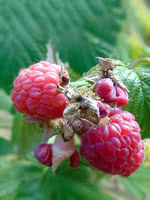Mon-Fri 9am - 5pm Mountain time
Black Elderberry vs Wild Red Raspberry
Sambucus canadensis
Rubus idaeus
NOT AVAILABLE THIS SEASON - MIGHT RETURN
Black Elderberry is a deciduous shrub native to eastern North America. You can plant this shrub in moist areas and it will help stabilize your soil. You can also use it on rural properties anywhere you'd use a lilac.
Black Elderberries are considered to be partially self-pollinating. So while they will still produce some berries without cross-pollination, planting with another variety will increase yields. Consider planting with Ranch Elderberry or Bob Gordon Elderberry.
Warning: the seeds, stems, leaves, roots, and uncooked berries of the Black Elderberry are poisonous to humans when eaten in quantity. You should cook the berries to make them safe for human consumption.
The Wild Red Raspberry produces small, tart, red berries. They are delicious when eaten fresh, but also add flavor to preserves or desserts. They are highly suckering and can be high yielding.
The Wild Red Raspberry is also otherwise known as the American Red Raspberry, European Red Raspberry, Grayleaf Raspberry, or the Common Red Raspberry.
The Wild Red Raspberry are floricanes, primarily fruiting on second year canes. Each spring cut back all two-year old canes, leaving only the last year’s growth. This is a self-pollinating variety, so it doesn’t require a second plant nearby to set fruit.
Black Elderberry Quick Facts
Wild Red Raspberry Quick Facts
Toxicity: leaves, stems, and uncooked berries are poisonous to humans

